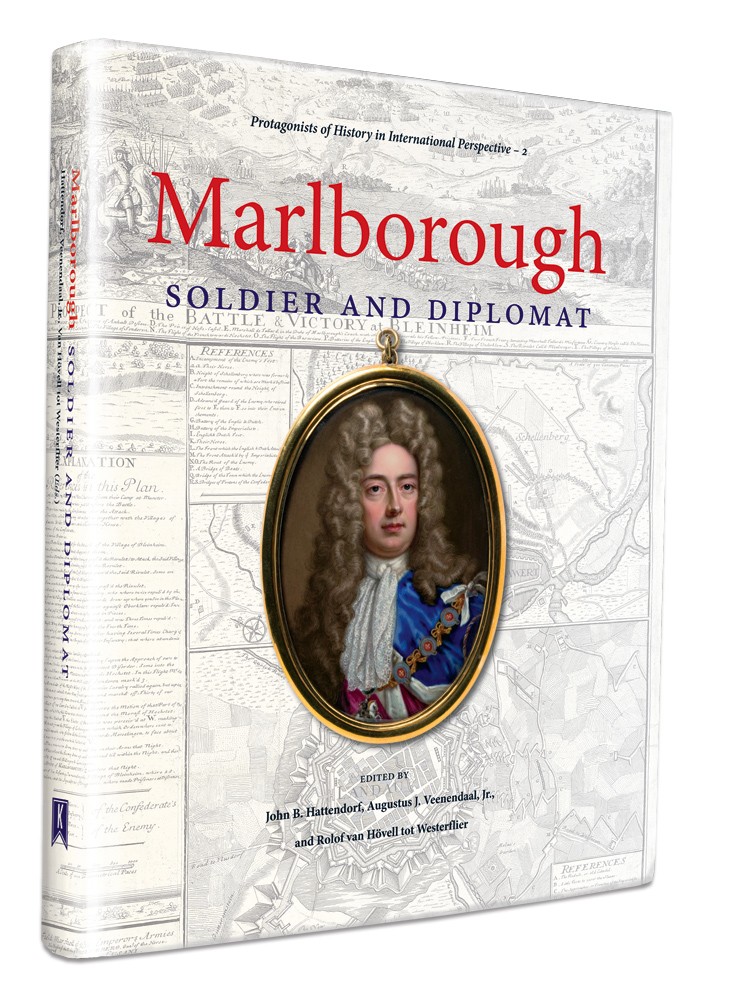Reviewer: Wouter van Dijk
Marlborough: Soldier and Diplomat, edited by John B. Hattendorf, Augustus J. Veenendaal, Jr., and Rolof van Hövell tot Westerflier (eds.)
Karwansaray Publishers, Rotterdam 2012
ISBN: 978 94 90258 04 7
Hardcover with dust jacket, lavishly illustrated, with maps, bibliography, notes and index
408 pages
€75,00
Marlborough in a European context
Outside Great Britain the name of John Churchill, first Duke of Marlborough will be far from familiar to those interested in history, apart from the few professionals studying his era. The general public in the Netherlands, Belgium, France and Germany will have little knowledge of this English general from the eighteenth century and that is a pity. Maybe it is because of the later claim laid on him by the English as ‘Britain’s greatest general’, or because of nineteenth century nationalist history-making in general but Marlborough should be far better known all over Western Europe for his role in the War of the Spanish Succession both as soldier and diplomat. The war affected the whole of Europe, and the Duke played a key role on the side of the Grand Alliance in this war.
This second volume in Karwansaray’s Protagonists of History in International Perspective series consists of twelve chapters by different authors from different countries, each dealing with a part of the Duke’s life and career from a different point of view. Historians specialized in the history of the countries involved in the conflicts Marlborough participated in describe his role and behavior against the background of their respective country of specialty.
It is impossible to treat every chapter of the book in this review but a general impression can be given by mentioning some of them. In the first chapter David Onnekink sketches the context of ‘Great Britain in the age of Marlborough’, thereby explaining how Britain, in the years around the War of the Spanish Succession, could develop into a world power. Indispensable in a book about Churchill is of course a biographical sketch, in this case provided by John B. Hattendorf. He gives a very detailed portrait of the Duke, in which his political rise and fall through his wife Sarah and his political career are the two dominant markers. Then there is a very interesting chapter by Alan J. Guy about the military profession in England and Britain in Marlborough’s time and a chapter especially focusing on the Duke’s attitude to and skill in siege engineering, or rather his lack of it. Jamel Ostwald, author of this contribution, also makes a justly statement about the role of Marlborough, and the English in general, in the siege warfare in the Allied army. Their part in this essential branch of warfare has been, and is, greatly exaggerated in a lot of Anglocentric literature on the subject. The reason for this single-mindedness lies in the use of sources, especially primary sources. English authors tend to use English source material only, which gives a much-distorted image of the actual contribution of the English to Allied siege operations. Most of the time these were carried out under supervision of a Dutch chief engineer, and the English part of the army played only a minor role in the proceedings.
John Stapleton’s chapter about Marlborough and the campaigns of 1702-1706 also shows that the existing literature is for a great part unilaterally focusing on Great Britain and the conduct of the English. The myth about the Dutch Field Deputies so burdensome to Marlborough and hindering him turns out to be perfectly rational behavior of government agents listening to other, more experienced generals in Marlborough’s staff, who were disagreeing with the Duke about the strategy to be followed. Stapleton also states that Dutch States-General did not make him supreme commander of the Allied forces because they saw him as their powerful savior as his descendant Winston Churchill put it, but because they didn’t saw him as a threat to their positions. A prince George of Denmark or another prince of Orange was far more likely to cause trouble in that respect, with their much more influential entourage and connections. Stapleton delivers a very refreshing and balanced account that should be compulsory reading for everyone interested in the subject, especially Anglo-Saxon historians studying Marlborough and the period.
Following Stapleton’s chapter is Veenendaal’s contribution about the Duke and Anthonie Heinsius, Grand Pensionary and de facto leader of the Dutch Republic after the death of William III. Exploring their relationship Veenendaal concludes that the two were not really friends, but merely working together for the common cause. This is illustrated most evidently by their correspondence, which nearly ceased to exist once Marlborough had to leave office.
An entertaining, though not very surprising, contribution forms Clément Oury’s chapter focusing on ‘Marlborough as an enemy’. In French historiography the Duke has gone down as a greedy warmonger who owes his victories on the field of battle more to the incapability of his enemies than to his own genius. The chapters Bernhard R. Kroener and Michael Hochedlinger reveal a lot about the dealings of the Austrian Habsburgs during the war, in which the Duke showed himself also a gifted diplomat as well as a successful soldier. After Jaap R. Bruijn’s article concerning warfare at sea during the wars Marlborough fought in, we find the last two chapters of the vast, extremely lavishly illustrated book, dealing with the image of the Duke in the British press and the way he was displayed in the arts, during and after his lifetime. As far as his press image concerns there can be made a clear distinction between his pre- and post-1710 image. Before that year he was applauded and cherished. After 1710, coinciding with the Tory power takeover, he quickly lost his status and position. However, the pre-1710 image has survived its negative counterpart and that paved the way for the title some honor him with as ‘Britain’s greatest general’.
After having given an overview of the contents of the book, a few words have to be spoken about the book itself. It is printed full-color, very beautifully illustrated, with a tremendous amount of photographs, many full page. It is a truly luxurious edition. But having said that, the most important part of the book is of course its content. The great value of this extensive book is that it deals with Marlborough in a truly European context and on a wider scale than the narrow British-minded publications that appear most of the time. The variety of the many contributing scholars with their different specialties and focus points provide for a masterly publication and a must have for anyone interested in the War of the Spanish Succession or the Duke himself.
Wouter van Dijk
